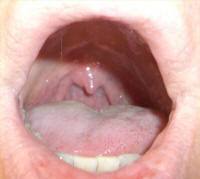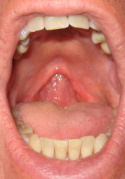OSADiary.com
Andrew's Sleep Apnea Surgery Diary
(last updated 6/30/08)
Andrew's throat before and after surgery
("look ma, no uvula!")
One year post surgery
Andrew's voice before and after surgery
|
|
|
|
Andrew's voice before surgery |
Andrew's voice 4 weeks after surgery |
Important Note
The surgery described below did not work - in fact, it made me worse than before. If you read nothing else, please be sure to read the conclusions at the end.
Contents
- Acknowledgement
- MySleepHistory
- Examination at Facial Reconstructive Surgical and Medical Center
- My Surgery and Recovery
- Conclusions
- Resources
Preface
In March of 2007 after years of living with obstructive sleep apnea (OSA), I had surgery in an attempt to correct the problem. I had used CPAP successfully for 9 years, but found the CPAP machine to be burdensome in a variety of ways. This diary chronicles the process of diagnosing my sleep apnea, my search for a better cure than CPAP, the surgery I underwent, and, in particular, the recovery process. To my dismay, not only did the surgery not make me better, in fact it made me significantly worse.
Acknowledgement
Special thanks to Brian, of Brian’s Snoring Surgery page. I don’t know Brian, but I found his page invaluable in making my surgery decision. While doing my research I talked to doctors, friends, relatives, experts, and lay-people. I spoke to people who had had this surgery done – some at the place I had mine, some at other places. Of all these sources, Brian’s page was the clearest and most helpful to me in coming to a conclusion. Though my results were the opposite of his, it is in the spirit of Brian’s page that I am writing up my experiences.
Sleep Apnea and my Surgery
There are many fine resources online and in print for information on sleep apnea. I will not repeat the information here. In the following discussion I assume that you already understand what Obstructive Sleep Apnea (OSA) is and the treatments that are available. The previously credited Brian’s Snoring Surgery page https://www.ski-epic.com/snoring/surgery.html has excellent information. My surgery was performed by Dr. Hester at Facial Reconstructive Surgical and Medical Center, http://www.sleepsurgery.com/.
My Sleep History
Throughout my life, as far back in childhood as I can remember, I have slept "a lot." I never really knew what "the right amount" should be, but from simply observing the world around me it was clear that I slept more than most people did, and that I was more tired in general than most people seemed to be. I can recall asking my doctor in my early teens about this. This was the mid-1970’s – I don’t think the notion of "sleep science" had been invented yet. Certainly my doctor didn’t know anything about it. I complained that I slept 10+ hours an night and was always tired. He suggested that I try sleeping at different times – perhaps going to bed earlier or later, perhaps getting up earlier or later. He suggested trying different things like eating before bed, or not eating before bed. To his credit he tried to be helpful, but in the end he just said, "Normal is 8 hours, but like everything it is a bell curve. Some people sleep more, some people sleep less."
That set of advice and commentary, in one form or other, was repeated to me by doctors throughout my life. Every time I went to a new doctor I would ask them about my sleepiness. The answers ultimately amounted to my being "outside the norm," but that didn’t mean there was anything wrong with me.
In 1998 I couldn’t stand it any more. I had asked my then-current doctor about sleepiness for the umpteenth time, and he told me the same old story. However, by this time sleep sciences were well established, so he should have known better! I told him that I wanted to have a sleep study done. He said that he didn’t feel that was appropriate and wouldn’t write a prescription for me. I said, "screw it," and decided that I would just pay for a sleep study myself. At the time a sleep study cost $1500, but I needed to know for the sake of my sanity why I slept so much.
I was living in Seattle, Washington. I called around to a number of hospitals. In the end chose the Sleep Study center at Virginia Mason Hospital. I made an appointment with a doctor named Daniel Loube at their center. He examined me and opined that I did not fit the "standard" models for people with sleep apnea, but nonetheless he gave me a huge questionnaire to fill out and scheduled me for a sleep study.
My First Sleep Study
I went in for my first sleep study at Virginia Mason on April 30, 1998. Since they weren’t sure what my problem was, I was scheduled for a full night sleep study plus additional tests throughout the following day. The idea was that they would observe me all night and then during the day they would watch me while I was awake, and also have me take naps and observe those as well. I arrived and got set up with the full sleep-study regalia, including EKG stuff, breathing sensors, arm and leg motion sensors, and so on.
The next morning I was awoken by the staff and told that I could go. I said, "wait, you’ve made a mistake. I’m supposed to be here for the whole day."
"That’s OK." I was told. "You don’t need to stay. It’s as clear as a bell. You have significant sleep apnea. It will take a couple weeks for us to analyze all the data, but we won’t learn anything more by keeping you here during the day."
Wow!
I subsequently met with Dr. Loube to discuss the results of the sleep study which showed that I had "moderately severe" sleep apnea, with an apnea index of 48. That meant I stopped breathing 48 times per hour - once every 1.25 minutes through the night! Furthermore, my longest apnea was over 1 minute. Ouch. That’s gotta be bad for the brain.
I was then scheduled for a second sleep test to find the correct CPAP pressure (which came out to be 13psi), and got my first Auto-CPAP machine.
Learning to Live With CPAP
Getting my first CPAP machine was quite an experience. Clearly I had not actually slept for years. Further, my body was used to being prone for 9, 10, 11 hours per night in order to give my brain the sleep it needed. Many people report not being able to stand the CPAP mask initially, though I had no trouble – I was so systemically sleep-deprived that there was almost nothing that would keep me awake. Breathing with a CPAP machine is like trying to breath facing into a hurricane, and the mask is uncomfortable and claustrophobic but it beats the alternative.
Once I was on CPAP, I started having weird experiences. Three or four hours into the night my brain would have had enough sleep and would wake up, but my body was still asleep, since it was used to many more hours. I had repeated odd and unpleasant out-of-body type experiences and dreams where I was awake but trapped in my body. After a few nights I was waking up fully at 4am or 5am, awake, but not really knowing what to do, since it was the middle of the night.
In spite of these unsettling and sometimes unpleasant sleep experiences, the overall effect on my life was staggeringly positive. I was awake and alert all day, I felt energized and upbeat. I was thrilled to have this problem solved. I was also happy to know that all these years I hadn’t been crazy – there really was something wrong. At the same time I felt like I had been robbed of years of my life by not having discovered my sleep apnea earlier. I was thankful and hopeful for the future, but saddened about what might have been had I known about my apnea.
Over the course of the ensuing months my sleep evened out, the odd sensations went away, and I started living a "normal" life sleeping about nine hours a night.
Life with a CPAP machine, though worlds better than with untreated apnea, can be a pain in the ass. Traveling with a CPAP machine presents special problems. Traveling internationally I always had to carry bags of power adaptors and extension cords. I couldn’t stay in that cool grass hut on the beach in Fiji – no power. One night I discovered that my hotel in Brussels turned off the power in the rooms at midnight! I learned that a number of historic hotels in Europe have no electric outlets in the rooms at all. Travel was hard on the machine and I had to have it repaired twice in foreign countries – once in Bangkok and once in Sydney. Camping meant not sleeping (and keeping my companions awake all night with my snoring.) Sleeping on airplanes was similarly problematic. Finally, there was the periodically repeated social drama of explaining the situation to every new partner (though they were all astonishingly sanguine about it.)
From time to time I would find an ear-nose-and-throat doctor to look at me, or I would make an appointment with a sleep doctor to find out if there was anything new to solve the problem. Some suggested that they could cut out my uvula, others gave me info on the UPPP (uvulopalatopharyngoplasty) procedure, but their answers were always very speculative. Basically they were suggesting doing surgery and seeing what happened. As far as new tools or techniques, the answer was always negative. On two occasions dentists made devices that I was to wear in my mouth at night to pull my lower jaw forward and create space in the back of my mouth. In each case I got such bad TMJ (Temporomandibular Joint pain) that I had to stop using them. The second time, after using a torture device called a "PM Positioner", it took almost two years before my teeth met correctly again. I also had a set of "pillar implants" put in. They were said to be effective for snoring and sometimes effective for OSA. For me they had absolutely no effect on either. Another $1000 down the drain.
Reading online I kept on running across the names of Drs. Powell and Riley and their work at Stanford on sleep apnea. Finally I decided to look them up and see what they could do for me.
In November, 2005, I was going to San Francisco for a class, so I decided to use the trip as an excuse to meet with Powell and Riley at their practice, Facial Reconstructive Surgical and Medical Center. As it happened, neither were available at a time that matched my schedule, so I made an appointment with their partner, Dr. Jerome Hester.
Dr. Hester was extraordinarily generous with his time. He did a very thorough examination and presented a lengthy discussion of my options. Unlike the prior doctors who basically shined a flashlight in my mouth and opined that maybe removing my uvula would help, Dr. Hester really examined me. We started will x-rays of my neck, both side view and full round-the-head x-rays. Next he ran a fiber optic viewer through my nose, into my mouth, and down my throat. With the viewer in place he had me lean forward and back; then had me hold my nose and close my mouth and inhale. He really checked to see what happens in my throat when I breathe and when I choke.
His conclusion was that I have a large uvula, very little space at the soft-palate, and a large base of tongue. The solution, he felt, was UPPP (uvulopalatopharyngoplasty), tonsillectomy, and genioglossal (basal tongue) advancement with radio-frequency somnoplasty to the back of the tongue. He felt that these procedures taken together were likely to solve the problem. We discussed Hyoidal bone advancement as well, but he didn't feel that was called for. He said that for most patients he could offer a 90% chance of success, but since my condition was so bad he was only willing to give me an 80% chance of being cured. Though not explicitly stated, he implied that if I wasn't cured, I would at least be improved. There was no discussion of the possibility of my condition being worsened.
One interesting note was his examination of the x-rays. Measuring the x-ray he noted that my airway when awake and upright was only 6mm, where it should have been more like 16mm! He commented that even without a sleep study he could guarantee that I have sleep apnea; the physical structure of my throat made it inevitable.
We talked at length about the recovery process. Unfortunately, he told me that the recovery would be extremely painful. He said that it was likely to be the most painful thing I would experience in my life! I’ve had a lot of doctors do procedures while saying, "this might pinch," and to me it hurts. When they say, "this will hurt a bit," generally it hurts a lot. To have a doctor tell me that I would experience the worst pain of my life, was really something to think about.
It was interesting to note that Dr. Hester was suggesting an 80% chance of success for me (and 90% in general) when the literature had success rates for UPPP running less than 45%. From meeting with Dr. Hester it was clear why he was able to claim such a high success rate. First and foremost, at Facial Reconstructive Surgical they actually examine patients and look to see what is going on in the throat. Every other surgeon I’d met with or heard about just wanted to cut some stuff out and see what happens. Considering all the surgeons in the country that do OSA surgery by just removing the uvula and some surrounding tissue blindly, I’m sure that the success rate overall must be terrible. Furthermore, Drs. Powell, Riley and Hester have found that most patients have multiple points of blockage. The uvula and palate are almost always involved, but the back of the tongue is frequently involved as well (as in my case.) Thus, with most non-specialists attacking just one area of blockage, it is no surprise that they have poor results. It is astonishing to me that any surgeon would put someone under the knife without looking first. This is clearly an area for specialists only. Surprisingly, in the end, even this extensive exam didn't point the way to a cure for me.
A Year Goes By
Dr. Hester’s warning about the recovery pain, along with the fact that any surgery has inherent risks, made me truly hesitate. I thought about it, I pondered it, and I ignored it. I looked for more information online. I spoke to a reference from Dr. Hester’s office. I spoke to a distant relative who had had the procedure done by Dr. Riley some years back. I spoke to a friend of a friend who had had UPPP done by another set of surgeons. Most importantly, as noted above, I read and re-read Brian’s Sleep Surgery page.
My father thought I was insane to consider surgery when a non-invasive solution (CPAP) was effective, but the CPAP machine was getting more and more annoying all the time. The prospect of an 80% chance of being cured was just too alluring. In addition, as the years had gone by I found that I was getting more and more tired again. I couldn’t help wondering if the 2-3 apneas per hour that the CPAP machine allowed, or the discomfort of the CPAP itself, were interrupting my sleep. I wondered if it were possible to "cure" my OSA altogether, providing even better sleep than that allowed by the CPAP machine.
November 2006 - I Finally Decide to Go Ahead with Surgery
It took a year, but I finally decided to do it. I weighed the factors that made CPAP inconvenient, uncomfortable, and possibly less than 100% effective against the danger of surgery, post-operative pain, and financial cost, and came up with the decision that I had to try to solve this problem once and for all.
At this point I started looking into the cost issue and was stunned by what I learned. While my insurance company pre-approved the surgery, they would not tell me how much they would cover and how much cost I would be responsible for! They went over in detail how my coverage worked, and what percentage of each thing they covered and I had to pay, but they would not tell me what "negotiated rates" they had with Stanford Medical Center. So, they would tell me that I had to pay 20% of the hospital room (for example), but they wouldn’t tell me what the cost of the room would be.
I called Stanford and tried to pump them for information, but they were equally tight lipped. The rates negotiated between the hospital and the insurance company are secret, and no one would tell me what they were. Finally I called Dr. Hester’s office, but they could only tell me their own fees (which were out-of-network with my insurance company.) They were able to opine that if I paid for everything 100% out of pocket at full non-negotiated rates, the whole thing would be about $80,000. Wow.
Finally I decided to go ahead anyway and hope for the best on insurance coverage and negotiated rates. However, I must say that it is no wonder the USA has spiraling health costs if it is impossible to find out what a pre-planned surgery might cost! How is a consumer to make intelligent choices or in any way contain medical costs if the prices of procedures are a secret until after they are done. Is there any other product or service in the world that is purchased without knowing the price? I think not! Geesh!
February 20, 2006 - Three weeks pre-surgery
At three weeks before surgery I stopped taking all aspirin, Advil, Aleve, and anything else that might thin the blood.
March 8, 2007 – Pre-op visit with Dr. Hester
On the Thursday before my surgery I went in to Dr. Hester’s office for my pre-op visit. They took a full set of x-rays, then Dr. Hester spent a long time with me telling me everything I could ever want to know about the surgery and the post-operative recovery, and answering every question I could think of. He was always amazingly generous with his time. (As a side note I have heard that this is not true of Dr. Riley.)
March 12, 2007 – The day before surgery
I had picked up my mother and sister at the airport the day before. They were in town to take care of me during my recovery. I spent the day showing them around the area, getting them acquainted with my house, car, and dog. It was a very pleasant day.
Since I wasn’t allowed to eat or drink after midnight, and I wasn’t anticipating much of anything to eat for the next week, we went out for a "final" dinner at Chez Panisse. It was, of course, superb. I tried not to think of it as my "last supper."
March 13, 2007 – Surgery Day!
My surgery was scheduled for 11:10am, and I was to be at the hospital by 9:10am. Since nothing was to pass my lips after midnight, that meant no coffee this morning. Its hard to face a nervous day without the drug of choice. Also, the traffic was terrible. It was just one of those weird days where everyone on the highway was hitting each other instead of driving. The traffic in Palo Alto was no better. As a result, I didn’t make it to the hospital till almost 9:30am. Fortunately this turned out to be OK. I got checked in, filled out all the requisite paperwork, and was taken to a changing room where I changed into a very chic hospital gown and some rather odd stockings which are designed to help decrease the danger of blood clots in the legs. After taking my vital signs, I was brought to a pre-op waiting area to lay and wait.
At about 11:00am my anesthesiologist arrived and put in an IV drip. He also gave me a shot of something which he said was not the anesthetic, but rather something to make me relaxed and calm while waiting.
That is the last thing I remember. I am told that I was awake for quite a while after that and had conversations with the anesthesiologist, the nurse, and Dr. Hester, but I don’t remember any of that at all. The surgery apparently took almost 2 hours.
Some time that afternoon I woke up in a bed in the hospital’s intensive care. They asked me how much pain I was in – I think I held up 8 fingers, and was given 4mg of morphine through my IV. I had a breathing tube in my nose, which extended down into my throat and was scratchy and uncomfortable. My arm hurt from the IV. My chin was totally numb. My neck and shoulders were stiff, but I didn’t want to stretch because doing so made the nose tube scratch my throat. There was a mask-like thing in front of my face blowing humidified oxygen into my nose and mouth. It was noisy and inconvenient, but I was so out of it that I didn’t really care.
I was uncomfortable talking and just used hand signs whenever anyone wanted to communicate with me. At some point my mother and sister came in. I recall they were allowed to be with me for ½ hour at a time. I was given shots of morphine every hour or hour and a half (I never quite figured out the rule.) Time was very fluid. I think they were allowing me 6mg of morphine every 3 hours, and I think they were giving me 4mg in one shot and then another shot with 2mg an hour and a half later. I really don’t know. I do recall thinking that morphine was worthless crap (though the next day when I wasn’t being given morphine any more I definitely thought that it was pretty damned fine stuff!) Overall the experience was uncomfortable and unpleasant, but not nearly as horrible as I had feared.
At some point (prior to the surgery, I believe), a set of air-pressure leg massagers was put on me – again to stop blood clots. Very high tech. Every thirty seconds the system would inflate or deflate one leg or the other to keep the blood moving.
At some point visiting hours were over. I slept on and off through the night for about an hour at a time. Sleeping in intensive care is very hard. There are lights on all over the place, there is always some alarm or other going off as some patient’s breathing system needs restarting, or someone needs medications, or whatever. In addition, the noise and action of my leg inflation system was hard to ignore. I was also having rather odd morphine dreams. Overall I’m sure that I must have been unconscious for some number of hours, but, I’m also sure that more than one night in intensive care must be awful.
March 14, 2007 – One Day After Surgery
In the morning I was moved from intensive care to an "ordinary" hospital room. I was so happy to be out of there! Though still noisy, the regular room was virtually quiet by comparison with intensive care. Dr. Hester came in about an hour later, looked at my stitches, and mercifully removed the nose tube (whew.) I was given another shot of morphine. However, that apparently was to be my last since I was no longer in intensive care with the kind of constant monitoring that morphine requires. My subsequent pain treatment was with Lortab, a liquid form of hydrocodone with acetaminophen. Unfortunately this required me to swallow, but re-learning to swallow is all just part of the joy of recovery. They warned me that I had to start swallowing things or I would not be able to get off the IV and I wouldn’t be leaving the hospital. Strong motivation!
To my pleasure, I found that I was able to talk. It really didn’t hurt to talk at all; however, in some way that is hard to explain, it was an effort. I could talk, but I didn’t want to. I’m not sure if that was due to trauma to the muscles of the throat, or drug-masked pain, or the drowsy effect of the drugs - talking was just kind of an effort.
The day came and went in its weird hospital kind of way. More Lortab every 4 hours, trays of food consisting of Jell-O, broth, tea, Italian ices and the like. Visits from my mother and sister, nurses checking my blood pressure and pulse. Sleep, waking, sleep, pain, recovery, attempts to swallow. The leg anti-clot devices were removed and I was able to take off the stockings as well. This was much more comfortable as they had felt rather restricting.
The one thing that I found surprising was the forms of pain I was experiencing. First off, prior to surgery I had imagined that my throat would just plain hurt all the time, and that cold things like ice-cream and popsicles would make it feel better. In fact, though uncomfortable, my throat wasn’t really in pain (as long as I was regularly on pain killers.) However, any swallowing was very painful and a large effort. It didn’t matter if it was warm, cold, or in between. Swallowing was bad, not swallowing was good. Unfortunately, swallowing is part of the healing process and they wanted me to swallow. I tolerated as much as I could. Generally I found that things that were hot were bad, and things that were very cold were bad. Melted sorbet seemed to be about the best temperature.
The other surprise for me was that my chin hurt a lot. Dr. Hester had told me that for most people the throat is so painful that the chin is a non-issue. Personally I found the throat to be much less painful than I expected (except when swallowing), but the chin was more painful, and in a more throbbing way, than I expected. Though my chin hurt a lot, I couldn’t feel my lower front teeth at all. Perhaps that was a blessing.
That night before bed I set up my CPAP machine and used it to sleep. The noises from the hallway, my roommate, and the nurses periodic checking on me and my roommate were certainly disturbing, but still, it was bliss after the ICU experience.
March 15, 2007 – Two Days After Surgery
I woke up fairly early, quite groggy. I had gotten sleep, though between the environment and the drugs I could hardly call it restful. I really wanted to go home. Unfortunately I had to wait for Dr. Hester’s approval. Apparently in about 5% of cases the back of the tongue remains too swollen to safely leave the hospital. Around 8:00am Dr. Hester came in and ran a fiber-optic probe down my nose to look at the back of my throat and tongue. He gave me the all clear.
It took a couple more hours for the nurses to get all the paperwork done, check me over, and give me my prescriptions and everything else I needed to leave. I was champing at the bit. I can’t really put my finger on exactly why, but I was desperate to get out of there.
My mother and sister came from their hotel, picked me up, and drove me the 45 minutes back to Oakland.
We had one weird experience on the way home. During the drive I asked my mother to call my local pharmacy to make sure they had my prescriptions in stock. Unfortunately, the writing on my prescription appeared to say "Lortas" (not "Lortab".) The local Long’s Drugs told her that they don’t stock it and it would be 5 days before they could get it in. I had her call another nearby pharmacy (Walgreen's). They said they’d never heard of it. Of course, we had the name wrong because the handwriting on the prescription form was so poor, but still, my mother told each pharmacist that it was the liquid form of hydrocodone. You would think that any accredited pharmacist would hear this and say "Ohhhh, you mean ‘lortab’, not ‘lortas.’" But no. We called pharmacy after pharmacy. Finally I pulled out my cell phone and with both my mother and I calling we scoured the area for some place to get my prescription filled. None of the pharmacists had a clue! This was insanely frustrating. I was starting to worry that I wouldn’t be able to get the stuff. Finally I called Elephant Pharm in Berkeley. Evidently this is a place where pharmacists actually have training. They knew that what I wanted was Lortab, and they had it in stock. By this point we had arrived home, so I went to bed and my sister kindly went off to Berkeley to get my pain killers. Whew! In addition to 10mg of Lortab every 4 to 6 hours, I was on a liquid antibiotic, at 2 Tbs every 6 hours.
Much as in the hospital, my throat and chin hurt whenever the pain killers wore off. Life became a slow, meaningless passage of 4-hour segments. I would be in pain and take a dose of Lortab. About 20 minutes later the Lortab would take effect and I would feel better. I’d try to drink some cool tea and eat some pudding. Some time in the next hour I’d be asleep. After about 3 hours and 45 minutes I’d start to be in pain again, and would hold on until the full 4 hours passed. I’d painfully swallow the next dose of medicine, go back to bed to wait for it to take effect, and then the cycle would begin again.
And so the hours passed. Pain, medication, no pain, sleep, grogginess, small bits of tea and pudding and melted ice cream.
March 16, 2007 – Three Days After Surgery
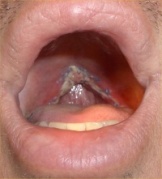
In the late evening, at night, and in the morning I was in the most discomfort. As the day wore on the pain would be less intense and I would be able to eat a bit more. When I looked in my mouth with a flashlight, the swelling had clearly been going down. The first day I couldn’t bear to open my mouth enough to look in. By this fourth day I was able to look in the mirror and even take a few photos. It is definitely ugly. The tissue was bright red and raw, the cauterized areas where sickly white, and the sutures were scary blue.
Otherwise, it was much the same day again. The only difference was that I was beginning to get very hungry – I was able to eat a scrambled egg.
March 17, 2007 – Four Days After Surgery
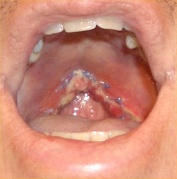
Days follow into days. Sleeping, taking pain-killers, eating soft foods like pudding and thawed ice cream, watching TV, reading, sleeping some more. The swelling continued to go down, the pain in my chin continued to be surprisingly bad. My lower front teeth continued to be completely numb.
As with prior days, it was quite painful swallowing the medicines during the night (though I woke up every 4 hours like clockwork as the pain kicked in.) I felt very bad first thing in the morning, but got better and better as the day wore on. By bedtime I was feeling poorly again. Sigh.
March 18, 2007 – Five Days After Surgery
For whatever reasons, mornings are the worst. Though I am up every 4 hours all night long taking my pain medication, each morning it is very painful swallowing the first dose of the day, and I really cant talk (or do much of anything) until about 20 minutes after that morning dose. Maybe the throat stiffens up during the night? Maybe it looses up? Maybe it is irritated by post-nasal drip. I have no idea, but mornings are bad.
Some time around noonish I was feeling well enough to shave! Yay. I’d been showering each day, but shaving was new. It wasn’t comfortable, but I felt better having the stubble gone.
For dinner I made Thai rice soup (khao thom moo.) It was very tasty, but afterwards I couldn’t get rid of the feeling that I had rice stuck in my throat. Ugh.
March 19, 2007 – Six Days After Surgery
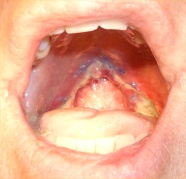
This morning was really, really bad. I’ve no idea why. Visually the swelling appeared be down, but god, getting that morning dose of Lortab swallowed was hard. As usual, 20 minutes later I was fine. I am ready for this to be over!
There continue to be signs that I am improving. Looking in the back of my throat, though still scary-ugly, it does appear less swollen. Also, while on past days every 3 hours and 45 minutes I would start to hurt and have to wait patiently for the final 15 minutes to pass between doses of pain-killers, today I found I was making it to 4 hours and 15 minutes before I went to the kitchen for my "fix." Doesn’t sound like much, but that is a big change. Finally, though my lower front teeth continue to be numb, there is more of a sense of presence than before (very hard to describe.)
One negative today was that for some reason the place where my IV had been began to hurt. Not super painful, but still surprising after so many days.
This afternoon I managed to eat my "solid-est" food yet – chunk light tuna mashed up with lots of oil and mayonnaise. It went down fine, though as with the rice, afterwards I had trouble cleaning it all out of my mouth and I kept feeling like there were clumps of tuna clinging to the back of my throat.
March 20, 2007 – Seven Days After Surgery
This was the first morning since the day of the surgery that I had to get up at a particular time. Nonetheless, I felt a little better this morning than on prior days. This was the day for my 1-week post-op checkup with Dr. Hester. My neighbor was kindly driving me down to Palo Alto, since due to the narcotics I couldn’t drive myself – I definitely didn’t want to be late.
At the doctors office they took another set of X-rays, then Dr. Hester examined my mouth and throat. All looked as expected. He showed me the before and after X-rays, which was very interesting. The hole in my chin from the genioglossal advancement was very scary. The first guy to try this procedure must have been one gutsy surgeon. The other interesting thing about comparing the X-rays was that, even though my tongue and palate were definitely swollen, post surgery there was already 3mm more space in the back of my throat than before.
Dr. Hester talked with me for a long time, answering all my questions about pain, medications, the healing process, etc. I really appreciate the time he has taken with me throughout all our meetings.
I was a bit exhausted by the time I got home, but for the rest of the day I felt better and in less pain than on any prior day. I don’t know if that was because of getting out of the house, or just that 7 days had passed.
March 21, 2007 – Eight Days After Surgery
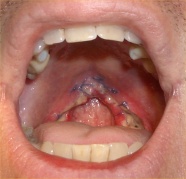
Strangely, though I had felt quite well yesterday, I slept very poorly during the night. I was up every hour and I felt like I was mouth-breathing. Each time I awoke my mouth and throat were dry and uncomfortable.
After a few hours this passed and I started to feel about as well as I had the day before. I even went out and did some light yard work.
Otherwise, and uneventful day.
March 22, 2007 – Nine Days After Surgery
I was definitely mouth breathing last night. The dryness was very uncomfortable so I set up a humidifier in my bedroom.
The swelling continues to decrease in small amounts, the things I can tolerate eating increase in their fibrousness, and my energy is overall on the rise. I can’t say the discomfort is over yet, but I can see the light.
The only other item of note is that I am finally able to whistle for my dog! Yay.
March 23, 2007 – Ten Days After Surgery
I finally stopped taking Lortab during the day, but am still taking it at night.
March 27, 2007 – Two Weeks After Surgery
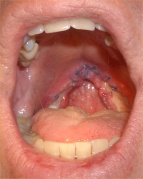
I’m feeling well. I’ve been completely off Lortab for a couple days now - I finally feel like I am back to "myself" again. Before the surgery I had said that I wished I could snap my fingers and have the whole thing be over. Today it feels like that has happened. The narcotic drugs made the prior two weeks turn into a blur – the time might just as well have evaporated, which is really just as well.
All of the stitches along my gum-line have fallen out, but most of the ones in the back of the throat are still there. There is some slight discomfort in my throat, and a dull ache in my chin, but it is all well handled with Aleve and Tylenol. I mostly can’t feel my lower front teeth at all. I am sleeping very well and my energy is returning.
April 2, 2007 – Three Weeks After Surgery
I haven’t taken any Lortab for over a week. The pain is virtually gone, though there is some odd numbness. The stitches in the back of my throat are tickling me rather badly. I wish they would fall out. I am eating pretty much anything I want, though my tongue doesn’t seem to be agile enough to clear bits of food debris from all parts of my mouth. I have to go to the bathroom and swish out my mouth after I eat anything. Some foods still feel like they are stuck in my throat, but I suspect that is actually the stitches.
I have started exercising again, which feels really good. Life is getting back to normal, however, I am not sleeping well and frequently feel tired. I suspect that my body is still working over-time on recovering. Further, it simply takes a while to get back in motion after almost 2 weeks of inactivity. I am now able to talk as much as I want without getting sore or tired.
April 5, 2007 – One Month Post-Op Visit
I was due to have a follow-up visit with Dr. Hester at 4 weeks, but he is out of town next week so we are doing it today, a few days early. It was a very brief appointment; my progress is exactly as expected. I still had a number of stitches in the back of my mouth that had not dissolved. They should have, but I guess my body isn’t caustic enough. Dr. Hester snipped them out for me. It is good having that mild tickling gone.
April 13, 2007 – 4 Weeks Post Surgery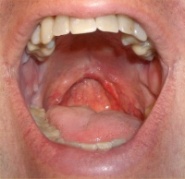
At this point life is pretty much back to normal. There is no benefit yet from the surgery (as expected.) Swallowing is "different" than before in a difficult to describe way, but not at all painful. I do notice the sensation of a band of scar tissue along my palate when I move the back of my tongue up to the back of my mouth, as when swallowing. I feel like I am able to move my tongue around to any part of my mouth, as was the case pre-surgery. However, it is a stretch to get my tongue over and in front of my front teeth, as one might do to clear food from between the front teeth and the lower lip. My lower front teeth are still basically completely numb, and though my lower lip itself has full sensation, the area from below my lower lip to my chin is mostly numb. This is not in anyway inconvenient or uncomfortable, just a bit odd.
To me my voice sounds, or perhaps feels, a bit different than before, but everyone tells me that I sound the same. My weight is currently about 3-4 pounds below where I was pre-surgery. Generally I feel like this was probably muscle weight. I don’t feel as strong as before, and I don’t think I look like I lost any fat (sigh.) This is a bit unfortunate as I really could stand to lose 10 pounds, and was kinda hoping that the surgery might help a bit more towards that goal. The most I was down at any point since the surgery was 7 lbs. Oh well, guess I’ll have to lose the weight the old fashioned way.
I basically feel fine about having had the surgery and about the recovery, though currently I must still wait for the benefits.
April 24, 2007 – 6 Weeks Post Surgery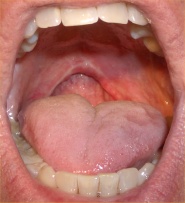
Life is definitely back to normal, I can do, eat and drink anything I want. I am noticing the scar tissue in my throat quite a lot. I don't know if this has something to do with changes in the scar, or the muscles or the nerves, but I am tempted to believe that the nerves are coming back to life, and so I am able to feel the scar in a way that I couldn't feel it before. Looking in my throat the scar is clearly visible as a white line across the rear-roof of my palate, though the palate overall is much smoother in appearance.
My tongue has regained considerable flexibility - I am able to move my tongue to virtually any part of my mouth. However, it does still feel somewhat stiff. I also notice tightness in my lower lip-gums junction. There is starting to be some return of sensation to my lower gums, mostly from the edges.
Friends tell me that my voice does not seem to have changed at all, and I am beginning to regain the ability to correctly pronounce words like "chutzpah", "France", and "fromage" with rolled "R"s.
May 8, 2007 - 8 Weeks Post Surgery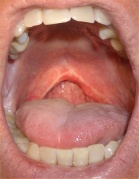
The annoying sensation of scar tissue in the back of my throat has abated. I can still feel it with the back of my tongue if I choose to, but it is not the nagging sensation I was experiencing two weeks prior.
Unfortunately, there still has been virtually no beneficial impact, neither subjectively nor objectively. Subjectively I am still sleeping 9.5 hours per night and feeling the need for a nap in the afternoon. Objectively the data output by my Auto-CPAP machine indicates no change at all in the pressure required to keep me breathing. There had been a period of 4 days during which the pressure readings were down, but then they went back up again.
Dr. Hester told me that I should not expect any impact for 6 to 8 weeks. It is now 8 weeks and I am feeling quite frustrated. I cant wait to experience some benefit, even if it is minimal. Sigh.
May 22, 2007 - 10 Weeks Post Surgery
Very little change over the last two weeks. There were a few days here and there where the data from the CPAP machine showed decreased pressures, but then they went back up again.
I called Dr. Hester to ask about what I should be expecting. He told me that 6 to 8 weeks was the earliest that I should expect results. He said that most people experience most of the improvement by 4 months (which is why they test at 3 to 4 months out,) but it usually takes a year for the full impact of the surgery, and for some people it takes a year before there is any meaningful impact. He also told me that neither my subjective feelings of wellbeing, nor the data from the CPAP machine are meaningful measures; I could have a significant improvement in my apnea but still get the same results from the machine. Basically, the only real measure is a sleep study, so I will have to wait for that.
June 5, 2007 - 12 Weeks Post Surgery
Virtually no change. From time to time I am aware of my throat, and I think more sensation is coming back in my chin and lower front teeth. Otherwise, nothing to report.
June 28, 2007 – Post Op Sleep Study
I went in for my follow-up sleep study at Bay Sleep Clinic in Berkeley, CA. Every sleep study I’ve had before was in a hospital’s sleep center. Bay Sleep Cinic is a chain of dedicated sleep centers. It was pleasant enough, though it seemed a bit lower-tech than the hospital sleep clinics; notably there was no intercom between the bedroom and the technician's room. When I had to get up during the night, I had to bang on the headboard to get the tech to come in and unplug me. During my prior sleep studies I simply spoke out loud and a technician heard me. I also noticed that after setting me up with all the sensors, the clinician did not go through a calibration process. In the past they have always had me blink my eyes, hold my breath, cough, wiggle my toes, etc. Odd.
I am concerned that the results are not going to be good. I was supposed to have stopped using CPAP for a week prior to the study, but every time I tried going without it I slept terribly, constantly waking up choking. Ugh. I didn’t make it through a single night without reaching for the CPAP. During the sleep study I woke up repeatedly and got a terrible night of sleep. In the morning I asked the technician if I had snored, and he said “yes.” Yikes! At the very least I shouldn’t be snoring!
July 19, 2007 – Meeting with Dr. Hester
I met with Dr. Hester to get the results of the sleep study. Its bad. Very bad. My new AHI number is 57! Formerly I had a reading of 44. The surgery has made me worse, not better. Dr. Hester said that he didn’t believe the number because there was virtually no oxygen desaturation during the night, which is basically impossible with a 57 AHI.
We discussed possible future steps: just continue to use CPAP; do Radio Frequency Somnoplasty to the base of the tongue (probably 4-6 treatments); do hyoid bone advancement; do mandibular advancement surgery (no way!); get an oral device made to move my jaw forward at night; etc.
Ugh. This requires some thought.
August 6, 2007 – Sleep Study Re-do
I spoke with Bay Sleep Clinic about the surprising numbers from the test and the fact that the technician hadn’t done a calibration. They offered to do a re-do for me. I went in to their San Francisco center for a do-over of my sleep study.
This time a calibration was done, and I slept a little bit better than I had the previous time, but still not well.
August 9, 2007 – Meeting with Dr. Hester
Given the bad news and the difficult decisions about how to proceed, I decided to go in and have another $750 “scoping” of my throat. It is an unpleasant procedure, but I needed to know what it looked like down there before going further.
Dr. Hester’s analysis was that my palate looked good - the surgery had been fully effective in enlarging the space at the top of my throat. Lower down, my epiglottis did not appear to be occluded, so hyoid bone advancement was probably not called for. However, the back of my tongue was still quite large and hung back into my throat. The genioglossal advancement had had little or no effect.
We considered doing somnoplasty, but Dr. Hester wanted to wait and see the results of the second sleep study before proceeding. I agreed.
August 15, 2007 – Sleep Study Results
Bad news, the number came back 57.4. The failure to do a calibration had not been an issue. Given how badly I’ve been sleeping (even with CPAP,) this did not come as a huge surprise, but I was anticipating that the surgery had had at least some beneficial impact. I am very depressed about this. In our many discussions, Dr. Hester made it clear that there were no guarantees. However, I had understood that I had an 80% chance of being cured, with the other 20% being improvement. At no time was there a discussion of my being made worse by the procedure. This is a disaster.
August 27, 2007 - Meeting with Dr. Hester for Somnoplasty
I met with Dr. Hester today for more conversation and a round of somnoplasty. The bottom line is that he doesn’t know why I got worse, and is not convinced that I did. He says that since my prior sleep study was more than a year ago, it is possible that I got much worse over that year, and I wasn’t really at an AHI of 44 before the surgery. I believe that is CYA bunk. Ten years ago I was at 48, one year ago I was at 44, and in that ensuing year I spontaneously went to 57 or worse before the surgery! Hardly.
The point is that I am no better off than before the surgery. I may or may not be worse than before the surgery, and the current state of science has no idea why that might be. I said that I thought he should cover the costs of at least getting me back to where I was (AHI = 44), but he didn’t agree. He said that the premise of what they do is that the airway is too small, and if they can make it bigger, it will make things better. He said that since he has clearly made the airway bigger, he has done what he set out to do. Why making the airway bigger did not make me better is unknown. So I am facing more pain and procedures as well as cost.
I decided to go ahead with a round of Radio Frequency Somnoplasty (RFS) at my expense. A somnoplasty treatment was done as part of my original surgery, but I was under anesthesia at the time, so I had no knowledge of the procedure. Afterwards I was recovering from the full set of surgeries, so I could hardly have said what part of the pain and discomfort was the result of the RFS. Thus, this was my first awake RFS treatment.
It started with Dr. Hester spraying a topical anesthetic into my throat. It was unpleasant tasting and stung a bit. He left for 5 minutes or so, then came back and gave me two big injections of anesthetics into the back of my tongue. It hurt a fair bit during the injection (about 5 seconds each,) but then my tongue began getting numb and the pain dissipated quickly. Again he left for some 5 minutes or so. Finally began the somnoplasty treatment. He pushed the needle of the RFS device into the back of my tongue and turned it on. It took about 3.5 minutes per side. Pushing the needle into my tongue felt like a strong pressure – unpleasant but not actively painful. As the power was applied, it felt like a mild pressure and burning – somewhat painful but not unbearable. In any case, the whole process was no fun.
When it was over my tongue was sore and puffy feeling and my jaw hurt. I felt like I was getting a headache, and my inner ears hurt a bit. I was able to talk, swallow, etc. immediately.
I drove home, feeling like I’d had a long procedure at the dentist. When I got home I took some of the painkillers that I had left over from the original surgery, then went to sleep. On awaking I felt much better – just a sore throat and kinda worn out feeling.
The somnoplasty was unpleasant, but not the end of the world. On the other hand, I’m not sure I can face doing it 3, 4, 5 or more times to get an effect.
I had a smoothy and ice cream for dinner. I could have forced myself to eat solid food, but I didn't want to.
By the next day I felt fine, with just a scratchy quality in my tongue.
October 4, 2007 - Second round of somnoplasty
I went in for a second round of somnoplasty. It was difficult to face the procedure a second time, but I did want to try to get results. This time was a little bit easier since I knew what to expect, and, more importantly, I brought my iPod with me to keep me distracted. It sounds silly, but the iPod really helped a lot. By distracting me from the details of the procedure, it wasn't quite as uncomfortable. It still was absolutely no fun, but not as bad. The drive home was just as unpleasant as before. The recover time was pretty much identical.
June 18, 2008 - Fifteen months post surgery
I finally arranged to have another sleep study to see how things were going, over a year after the surgery and approximately one year after my second somnoplasy. I had been intending to have the sleep study in March, but I kept putting it off - I think deep inside I didn't want to know.
The news was not good. The study showed that I now have an AHI (arousal index) of 81 (81 arousals per hour,) and an RDI (respiratory disturbance index) of 71. Before surgery my AHI was 44. Forty-four counts as "mildly severe." A score of 81 counts as "very severe." Thus, the surgery, fully healed, plus two somnoplasties, has made me significantly worse. Ugh.
Conclusions
This is a disaster. Not only has there has been no benefit from the surgery, I am actually worse. I went from a "moderately severe" AHI of 44 to a "very severe" AHI of 81. Pre-surgery I had my Auto-CPAP machine set with a minimum pressure of 6, and was generally having a “90% pressure” of about 9. Now I have my CPAP set to a minimum of 10, my “90% pressure” is about 12, and I am sleepy a lot. Ugh.
While I can say that the recovery process was not nearly as painful as I had anticipated, having a negative impact from the surgery is clearly a disaster. Obviously if I had it to do all over, I wouldn’t!
Dr. Hester claims that by making my airway bigger at the palate, I now have options open to me (like a dental device) that were not available before. It is possible that by doing several rounds of somnoplasty and/or a hyoid bone advancement, I might get to a cure. However, having rolled the dice once and come up snake-eyes, I am reluctant to roll again, and it sure seems like the somnoplasties made the situation worse still.
I anxiously await the next REALbreakthrough in sleep science.
Miscellaneous Thoughts
-
Dr. Hester should have warned me ahead of time that there was a non-zero possibility that I would get worse, not better. Even if I am the "one in a million" abnormality, he should have made me aware of that possibility.
-
I certainly understand why Dr. Hester was so careful to warn me about post-operative pain, and I am sure that some people do have extraordinary pain. In my case, and in the cases of everyone I have talked to, it really wasn’t that bad.
-
It appears to be vital to have people around to take care of you. I was so out of it on pain killers, it really wouldn’t have been safe or comfortable for me to have been recovering completely alone.
-
I have heard of people having UPPP and being sent right home. I definitely think that two days in the hospital receiving fluids through an IV is a crucial aspect of making the recovery work. In my case spending the first night in the Intensive Care Unit was overkill, but I understand why they take that precaution.
-
I have heard of people losing dozens of pounds during the recovery process. Not me. I would have loved to have lost 10-15 pounds. Oh well.
-
After the surgery it is important to sleep sitting upright. Before the surgery I looked at and bought several pillows designed for sitting upright in bed to read or work. Most of them have arms that stick out and hold you in place. I found all of these to be uncomfortable after about an hour, and for me, the arms made sleeping almost impossible. Finally I found a pillow that is simply a wedge with an extra lumbar piece Velcro’ed on. Its lack of arms made it very versatile, comfortable, and effective. The one I got is called the "Read and Relax 2-in-One Bed Pillow." I got it from Overstock.com, but it is sold by a number of web sites, and there are many other "wedge" style pillows available.
-
Apparently everyone has different feelings about what foods work best for them after the surgery. For me, pudding was the easiest thing to eat. I went for the Jell-O brand pudding with the least additives. I did try one package that included some gelling agents like gum agar, etc. That one was too stiff and gooey. After pudding, melted ice-cream and melted popsicles were best. I wasn’t able to suck on a popsicle, which was a surprise. I had bought a lot of stuff to make smoothies with, but I found that they were too thick and in some ways too astringent to eat. Dr. Hester recommended that I not stock up on too many things before the surgery, but rather buy a few things to try out and purchase more after I knew what I was able to tolerate. I agree with that recommendation.
-
Facial Reconstructive Surgical and Medical Center http://www.sleepsurgery.com/
-
Brian’s Snoring Surgery Page https://www.ski-epic.com/snoring/surgery.html
-
The Promise of Sleep by William C. Dement, available on Amazon.com
(c) 2007-2011, Andrew Sigal
